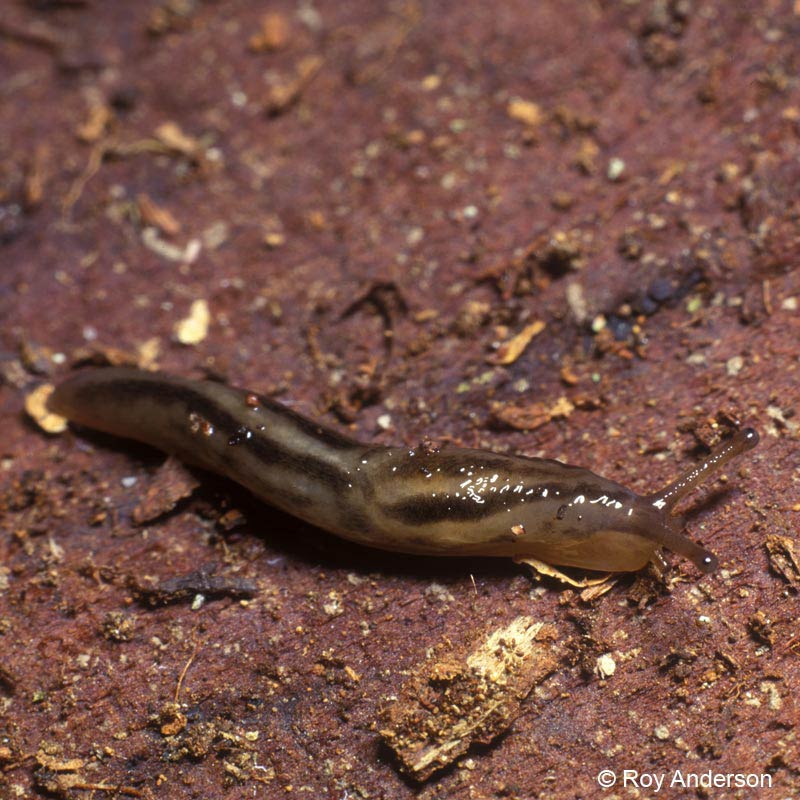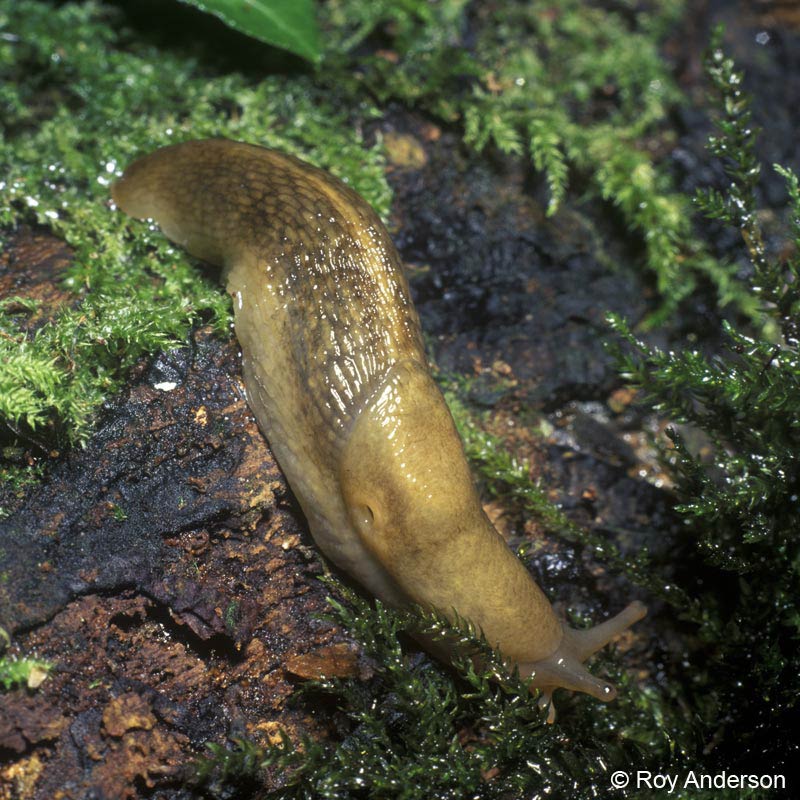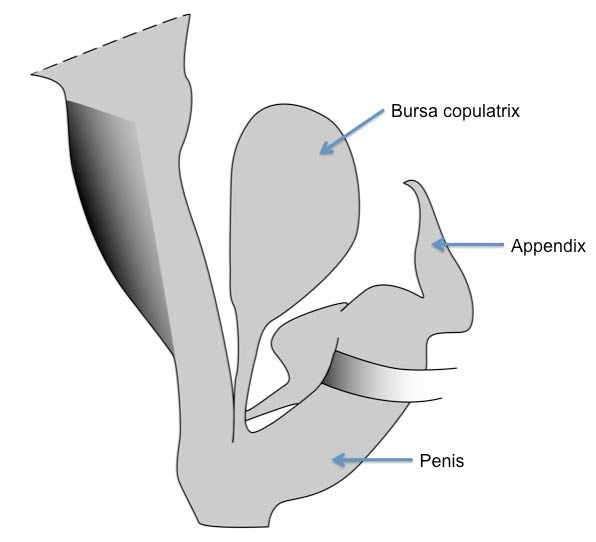Lehmannia marginata
|
Lehmannia marginata. (Photo: © J.K. Lindsey, The Ecology of Commanster) |
|
Lehmannia marginata. (Photo: © Dr. Roy Anderson, MolluscIreland) |
|
Lehmannia marginata. (Photo: © Dr. Roy Anderson, MolluscIreland) |
|
Lehmannia marginata: genitalia. (Photo: © K. Weigel, University of Florida) |
|
Lehmannia nyctelia: genitalia. (Photo: © K. Weigel, University of Florida) |
Family
Limacidae
Species
Lehmannia marginata (Muller, 1774)
Common name
Tree slug
Description
The tree slugSlug:
A snail that either does not possess a shell or has one that is very reduced (no definite coiling) or internal.
is variable in color, ranging from grey to reddish. There is a short keelKeel:
Also known as the carina. This is a longitudinal ridge that runs dorsally along the apex of the tail of the animal.
at the tip of the tail. The mantleMantle:
A fleshy, membranous covering of the anterior portion of the body of a mollusc. It secretes the materials that form the shell.
is very large in relation to the size of the animal (1/3 the length of the body). There are 2 dark-colored stripes on each side of the animal. The lower stripe often branches and may be difficult to see. On the other hand, the mantleMantle:
A fleshy, membranous covering of the anterior portion of the body of a mollusc. It secretes the materials that form the shell.
has three stripes, with the middle stripe being paler than the other two. The pale area between the bands on the mantleMantle:
A fleshy, membranous covering of the anterior portion of the body of a mollusc. It secretes the materials that form the shell.
forms a lyre shape (horseshoe-shaped). The pneumostomePneumostome:
This is the breathing hole on the right side of the mantle of molluscs. This allows air to pass through to the lung for gas exchange.(See also breathing pore).
(breathing pore) is located on the right, in the posteriorPosterior:
Directional term: the rear or tail end of an animal.
third of the mantleMantle:
A fleshy, membranous covering of the anterior portion of the body of a mollusc. It secretes the materials that form the shell.
. The sole is tripartiteTripartite:
Having three distinct section/regions.
(grey with a darker center). The mucus is clear and watery. There is a characteristic pale stripe running down the midline of Lehmannia marginata, and this characterCharacter:
1). A distinctive trait, quality or attribute used for recognizing, describing, or differentiating taxa; 2). The term used to denote such descriptive traits that possess states and are located within the Lucid version 2 (and later) interactive matrix panel. (compare feature)
is very useful to distinguish this species from L. valentiana. However if there is any doubt, the genitaliaGenitalia:
The reproductive structures of an animal. May refer to either male or female structure.
should be used to confirm the identity of the specimen. There is a European species called Lehmannia nyctelia that can be confused with this species. Genitalic characters are provided below for species determination.
The following species can be separated by dissection and observation of their genitaliaGenitalia:
The reproductive structures of an animal. May refer to either male or female structure.
:
Lehmannia marginata: The appendix on the penis of this species tapers to a point. It should be noted that the appendix might be inverted in this species.
L. valentiana: The appendix on the penis of this species is somewhat tubular or the apexApex:
The tip of the spire of a shell.
may appear expanded.
L. nyctelia: The appendix is lacking in this species.
Native range
Europe
Distribution
North America:
- U.S.: Oklahoma
Australasia: New Zealand
Europe
Ecology
This species inhabits gardens, forests, and open habitat but are rarely encountered in intensively cultivated lowland areas. Lehmannia marginata consusumes algae, lichen and mushroom. In the absence of prefered food material this species is reported to consume other mollusk species that are already dead, but are not known to attack other gastropods. Clutches of between 8-30 eggs are deposited in the soil and depending on temperature may incubate for approximately 35-130 days. Maturity is achieved in 8-10 months and longevity is approximately 2.5-3 years.
Synonyms
- Limax arborum Bouchard-Chantereaux, 1838
- Limax livonicus Schrenk, 1848
- Limax marginatus Muller, 1774
References
Abbes 2010; Anderson 2005Anderson 2005:
Anderson, R. 2005. An annotated list of the non-marine Mollusca of Britain and Ireland. Journal of Conchology 38: 607-637.; Branson 1980Branson 1980:
Branson, B. A. 1980. The recent Gastropoda of Oklahoma, part VIII. The slug families Limacidae, Arionidae, Veronicellidae and Philomycidae. Proceedings of the Oklahoma Academy of Science 60: 29-35.; Cowie 1997Cowie 1997:
Cowie, R.H. 1997. Catalog and bibliography of the nonindigenous nonmarine snails and slugs of the Hawaiian Islands. Bishop Museum Occasional Papers. 50.; Forsyth 2004Forsyth 2004:
Forsyth, R.G. 2004. Royal BC museum handbook: land snails of British Columbia. Victoria, Canada: Royal BC Museum. pp. 1-188.; Horsák et al. 2004Horsák et al. 2004:
Horsák, M., L. Dvorák and L. Juricková. 2004. Greenhouse gastropods of the Czech Republic: current stage of research. Malacological Newsletter 22: 141-147.; Kantor et al. 2009Kantor et al. 2009:
Kantor, Y.I., M.V. Vinarski, A.A. Schileyko and A.V. Sysoev. 2009. Catalogue of the continental mollusks of Russia and adjacent territories. Version 2.1. (Accessed online July 20, 2010); Kerney et al. 1979Kerney et al. 1979:
Kerney, M.P., R.A.D. Cameron and G. Riley. 1979. A field guide to the land snails of Britain and North-west Europe. Collins, London. pp. 288.; McDonnell et al. 2009McDonnell et al. 2009:
McDonnell, R.J., T.D. Paine and M.J. Gormally. 2009. Slugs: A guide to the invasive and native fauna of California. University of California, Division of Agriculture and Natural Resources 8336.; Thomas et al. 2010Thomas et al. 2010:
Thomas, A.K., R.J. McDonnell, T.D. Paine and J.D. Hardwood. 2010. A field guide to the slugs of Kentucky. Agricultural Experiment Station. University of Kentucky, College of Agriculture, SR-103.






